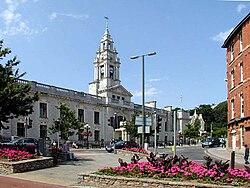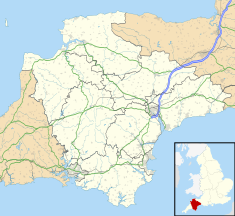
Torquay is a seaside town in Devon, England, part of the unitary authority area of Torbay. It lies 18 miles (29 km) south of the county town of Exeter and 28 miles (45 km) east-north-east of Plymouth, on the north of Tor Bay, adjoining the neighbouring town of Paignton on the west of the bay and across from the fishing port of Brixham.

Torbay is a unitary authority with a borough status in the ceremonial county of Devon, England. It is governed by Torbay Council, based in the town of Torquay, and also includes the towns of Paignton and Brixham. The borough consists of 24.27 sq mi (62.9 km2) of land around the east-facing Tor Bay, part of Lyme Bay on the English Channel. A popular tourist destination, Torbay's sandy beaches, mild climate and recreational and leisure attractions have given rise to its nickname of the English Riviera. The neighbouring districts are South Hams and Teignbridge.

Paignton is a seaside town on the coast of Tor Bay in Devon, England. Together with Torquay and Brixham it forms the borough of Torbay which was created in 1968. The Torbay area is a holiday destination known as the English Riviera. Paignton has origins as a Celtic settlement and was first mentioned in 1086. It grew as a small fishing village and a new harbour was built in 1847. A railway line was opened to passengers in 1859 creating links to Torquay and London. As its population increased, it merged with the villages of Goodrington and Preston. Paignton is around 25 miles (40 km) north east of Plymouth and 20 miles (32 km) south of Exeter.

Oldway Mansion is a large house and gardens in Paignton, Devon, England. It was built as a private residence for Isaac Singer (1811–1875), and rebuilt by his son Paris Singer, in the style of the Palace of Versailles.

St Marychurch is an area of Torquay, in the Torbay district, in the ceremonial county of Devon, England. It is one of the oldest settlements in South Devon. Its name derives from the church of St Mary, which was founded in Anglo-Saxon times. The ward population taken at the 2011 census was 11,262.

Torquay railway station is on the Riviera Line and serves the seaside resort of Torquay, Devon, England. It is 219 miles 79 chains (354 km) from London Paddington.
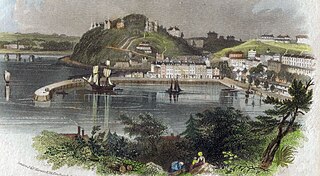
The History of Torquay, a town in Torbay, on the south coast of the county of Devon, England, starts some 450,000 years ago with early human artefacts found in Kents Cavern. There is little evidence of any permanent occupation at Torquay until the eleventh century records in the Domesday Book, though it is known that visits were made by Roman soldiers and there was a small Saxon settlement called 'Torre'. In 1196 Torre Abbey was founded here, which by the time of its dissolution in 1539, had become the richest Premonstratensian Monastery in England. The buildings were bought by Sir George Cary in 1662. The Cary family and the Briwere family between them owned much of the land now occupied by Torquay. By the 19th century, most of the land was owned by three families: the Carys, the Palks, and the Mallocks.

Torbay Hospital in Torquay is the main hospital of South Devon, England. It is managed by the Torbay and South Devon NHS Foundation Trust.

Reading Town Hall is the town hall of Reading, Berkshire, England. The town hall was built in several phases between 1786 and 1897, although the principal facade was designed by Alfred Waterhouse in 1875. Situated close to the site of Reading Abbey, it is adjoined to the north by the Hospitium of St John and to the south by St Laurence's Church.
Torquay Lifeboat Station was the base for Royal National Lifeboat Institution (RNLI) search and rescue operations at Torquay, Devon in England from 1876 until 1923. A second lifeboat was kept at the harbour from 1917 until 1928.

Hawkmoor Hospital, originally known as Hawkmoor County Sanatorium, was a specialist hospital near Bovey Tracey in Devon, England, founded in 1913 as a pulmonary tuberculosis sanatorium as part of a network of such facilities, instigated by the Public Health 1912. From 1948, the hospital catered for patients with a range of chest ailments, as well as chest surgery, and mental disability patients. From 1973, the facility dealt solely with mental health problems until its closure in 1987.
Torbay and Southern Devon Health and Care NHS Trust was a NHS trust that provided health and care in and around Torbay, Devon, England. It was a pioneer within the NHS in England in demonstrating the advantages of integrating health and social care into one organisation. And "one of three areas that have been working to learn from Kaiser Permanente, a leading United States health maintenance organisation." It was established as Torbay Care Trust in October 2005, with responsibility for social care in a partnership agreement with Torbay Borough Council. From then until April 2012, the trust had responsibility for both commissioning (buying) and providing integrated health and social care services to people in the Torbay area. As part of the changes associated with the Health and Social Care Act 2012 the commissioning function was detached from the trust.

Torbay Council is the local authority for Torbay, a local government district in the ceremonial county of Devon, England. Since 1998 the council has been a unitary authority, being a district council which also performs the functions of a county council; it is independent from Devon County Council.

Haldon Belvedere or Lawrence Tower is a triangular tower in the Haldon Hills in the county of Devon, England.

The Torquay Marine Spa was a swimming bath and entertainment complex situated on a promontory overlooking Beacon Cove in the town of Torquay, Devon, England. The buildings included a ballroom, concert hall, sunlit conservatory and private bathing facilities. There was also a large public swimming bath open to the sea below these.
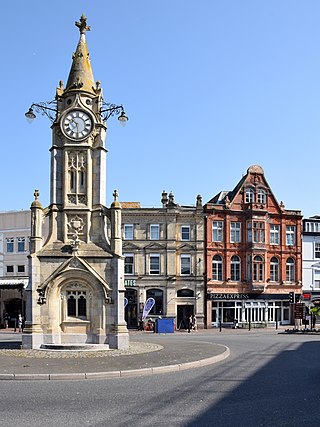
The Mallock Memorial Clock Tower is situated at the harbourside in Torquay, Devon, England. It is a Grade II Listed Building, and was first listed in 1975.

Brixham Town Hall is a municipal building in New Street, Brixham, Devon, England. The structure, which is the meeting place of Brixham Town Council, is a Grade II listed building.
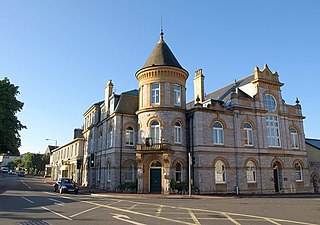
St Marychurch Town Hall is a municipal building in Fore Street, St Marychurch, Devon, England. The town hall, which is now used as a block of apartments, is a Grade II listed building.

The Old Town Hall is a former municipal building in Union Street, Torquay, Devon, England. The building, which was the headquarters of Torquay Borough Council until 1911, is a Grade II listed building.

The Old Town Hall is a former municipal building in New Street in Paignton, a town in Devon, in England. It served as the offices of Paignton Urban District Council until 1946, but was later converted for residential use.
